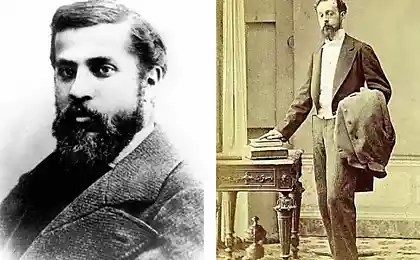170
Famous works of genius fantasist Antonio Gaudi
The most outstanding Spanish architect of the XIX-XX centuries can rightly be called Antonio Gaudí. The master is the creator of his unique style based on modernity. During his lifetime, Gaudí implemented 18 architectural projects, seven of which are now included in the UNESCO World Heritage List. Its most famous buildings are in Barcelona. The Palace of Güell, the Park of Güell, the House of Batlló, the House of Mila and the work of a Spaniard’s life – the Redemptive Temple of the Sagrada Familia – this is an incomplete list of Gaudí’s masterpieces. By the way, the last one has not been completed yet! During his lifetime, the architect spent 40 years on it, and according to the plan, the construction of the temple will be completed only in 2026.
6th place. House of Vicens.
The House of Vicens is a private house built between 1883 and 1885 by order of Don Manuel Vicens y Montaner. The building is Gaudí's first independent work. The property is located in the Grazia district of Barcelona. From 1899 until today, the mansion belongs to the Hoover family. Entrance is forbidden; you can admire the building only from the outside.
The house is made in Moorish Mudejar style. Its facade is decorated with tiles painted by hand.
The tiles depict yellow velvets.
5th place. Palace of Güell
The Palace of Güell is a residential building that was built in 1885-1890 by order of Eusebi Güell. The building is made in the style of Catalan modernism. The property is located in the Raval district of Barcelona. Visitors should pay special attention to the roof terrace and the central hall with a ceiling in the form of a starry sky.
The palace consists of four floors, a basement and a roof with a terrace.
The facade of the house is very strict and almost devoid of sculptural decoration. But, inside, Gaudí created a unique interior.
4th place. Park Güell
Park Güell is a park that was built in 1900-1914 by order of Eusebi Güell. On the territory of 17.18 hectares there are three houses. Visitors should pay special attention to the fountain in the form of a mosaic Salamander, “Hall of a hundred columns”, a bench in the form of a sea snake.
Park Güell is included in the UNESCO World Heritage List.
Park Güell.
3rd place. House of Batllo
The House of Batlló is a residential building that was rebuilt by Gaudí in 1904-1906 by order of Josep Batlló y Casanovas. The property is located in the Eixample district in Barcelona. The mansion itself resembles the curved back of a dragon, where the balconies are skulls and the columns are bones.
The House of Batlló is inscribed on the UNESCO World Heritage List.
House of Batllo.
2nd place. House Mila.
Mila House is a residential building that was built in 1906-1910 by order of the Mila family. The property is located at the intersection of Passech de Gracia Boulevard with Carré de Provence in Barcelona. The building has three courtyards, a roof terrace and an attic.
Mila House is inscribed on the UNESCO World Heritage List.
Mila's house.
1st place. The Atonement Temple of the Holy Family
The redemptive Sagrada Familia, one of the most recognizable temples in Barcelona and the world, was not completed by Gaudí himself, who dedicated it for about 40 years. Moreover, it has not yet been completed! Construction has been going on for 132 years with private donations. According to the Spanish government, the church will be completed no earlier than 2026.
The Atonement Church of the Sagrada Familia is included in the UNESCO World Heritage List.
Source:fresher.ru
Source: /users/1077
6th place. House of Vicens.
The House of Vicens is a private house built between 1883 and 1885 by order of Don Manuel Vicens y Montaner. The building is Gaudí's first independent work. The property is located in the Grazia district of Barcelona. From 1899 until today, the mansion belongs to the Hoover family. Entrance is forbidden; you can admire the building only from the outside.
The house is made in Moorish Mudejar style. Its facade is decorated with tiles painted by hand.
The tiles depict yellow velvets.
5th place. Palace of Güell
The Palace of Güell is a residential building that was built in 1885-1890 by order of Eusebi Güell. The building is made in the style of Catalan modernism. The property is located in the Raval district of Barcelona. Visitors should pay special attention to the roof terrace and the central hall with a ceiling in the form of a starry sky.
The palace consists of four floors, a basement and a roof with a terrace.
The facade of the house is very strict and almost devoid of sculptural decoration. But, inside, Gaudí created a unique interior.
4th place. Park Güell
Park Güell is a park that was built in 1900-1914 by order of Eusebi Güell. On the territory of 17.18 hectares there are three houses. Visitors should pay special attention to the fountain in the form of a mosaic Salamander, “Hall of a hundred columns”, a bench in the form of a sea snake.
Park Güell is included in the UNESCO World Heritage List.
Park Güell.
3rd place. House of Batllo
The House of Batlló is a residential building that was rebuilt by Gaudí in 1904-1906 by order of Josep Batlló y Casanovas. The property is located in the Eixample district in Barcelona. The mansion itself resembles the curved back of a dragon, where the balconies are skulls and the columns are bones.
The House of Batlló is inscribed on the UNESCO World Heritage List.
House of Batllo.
2nd place. House Mila.
Mila House is a residential building that was built in 1906-1910 by order of the Mila family. The property is located at the intersection of Passech de Gracia Boulevard with Carré de Provence in Barcelona. The building has three courtyards, a roof terrace and an attic.
Mila House is inscribed on the UNESCO World Heritage List.
Mila's house.
1st place. The Atonement Temple of the Holy Family
The redemptive Sagrada Familia, one of the most recognizable temples in Barcelona and the world, was not completed by Gaudí himself, who dedicated it for about 40 years. Moreover, it has not yet been completed! Construction has been going on for 132 years with private donations. According to the Spanish government, the church will be completed no earlier than 2026.
The Atonement Church of the Sagrada Familia is included in the UNESCO World Heritage List.
Source:fresher.ru
Source: /users/1077






















